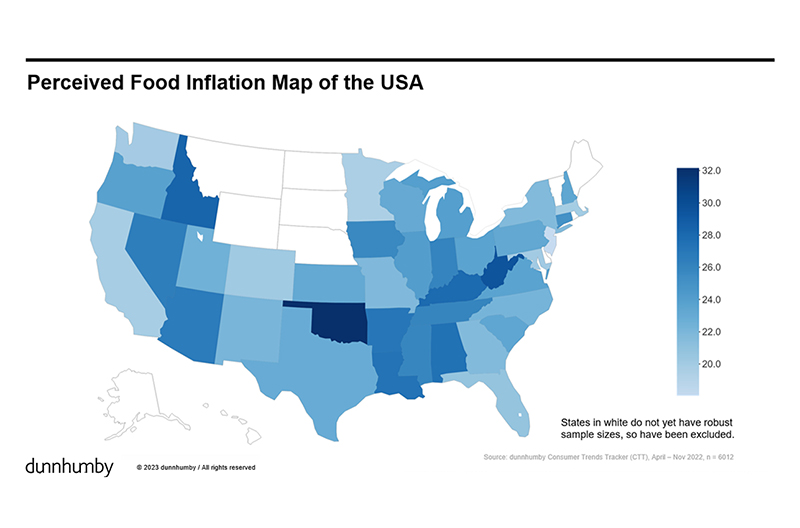Americans believe that grocery retailers are earning a 35.2 percent net profit margin, 14 times higher than their actual net profit margin average of 2.5 percent. They also think that food-at-home inflation is 24.3 percent, double the annual rate reported by the U.S. Bureau of Labor Statistics, according to the latest dunnhumby Consumer Trends Tracker.
In the third wave of the report, dunnhumby also found that despite perceived inflation reaching a new high, customers are coping better compared to the last wave of the report. Consumers who reported they would have difficulty covering an unexpected expense of $400 dropped from 64 percent in July to 60 percent in November. In addition, 48 percent of consumers reported they are getting the kind of food they want to eat compared to 43 percent in the second wave.
“In this latest wave of our CTT study, we found that retailers are in a precarious position with their brand perception, since customers are vastly over-estimating grocers’ store profit margins and inflation rates, while they themselves are battling food prices,” said Matt O’Grady, president of the Americas, dunnhumby.
“Retailers need to show they are empathetic to customers through their prices, their rewards/loyalty offers, and with messaging to best support shoppers during these challenging financial times.”
Key findings from the study:
- Inflation worries are driving customer sentiment. When consumers were asked why customer sentiment is the lowest it has been in 50 years, they responded by a five-to-one margin that inflation was the cause, with COVID-19 coming in a distant second. Over a five-year period, 54 percent of consumers are optimistic that their own finances and the state of the country will improve.
- Food insecurity remains a problem. Thirty-one percent of households reported they have skipped or reduced the size of a meal for financial reasons. Consumers living in Idaho, Oklahoma, Arkansas, Tennessee and West Virginia reported the highest numbers, where more than 40 percent had skipped or reduced the size of a meal in the last year. Consumers living in Washington, Minnesota, Michigan, Massachusetts and Maryland reported the lowest numbers, with about 20 percent having skipped or reduced the size of a meal in the last year.
- While improving slightly, most consumers continue to struggle financially. No state is immune, but the states with the highest rate of financial insecurity (75 percent) are Oregon, Oklahoma, Louisiana and West Virginia. The states with the lowest rates of financial insecurity (45 percent) are Minnesota, Wisconsin, Maryland and Delaware.
- Shoppers want easy to shop and more convenient e-commerce solutions. Eighty-one percent of consumers say easy-to-shop websites and apps are important to them and 78 percent want retailers to have more convenient delivery and pick up time slots.
- Consumers want retailers to help them make healthy choices. Forty-four percent of consumers reported it was very or extremely important for retailers to help them make healthy choices, an increase of 3 percent from the previous wave.
The dunnhumby Consumer Trends Tracker can be accessed here.

